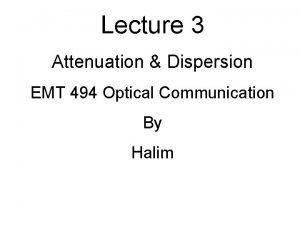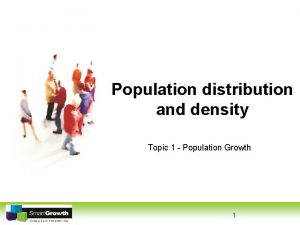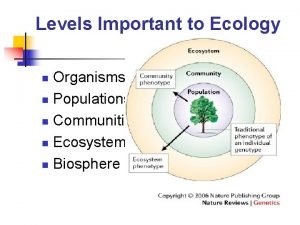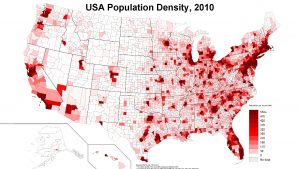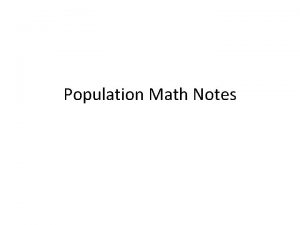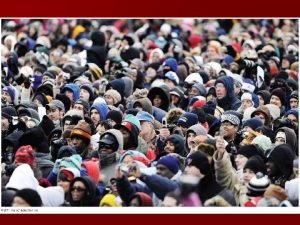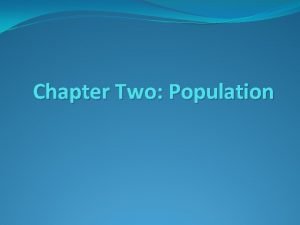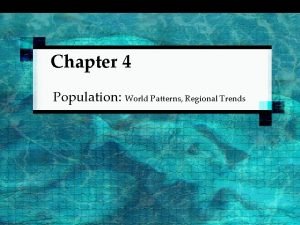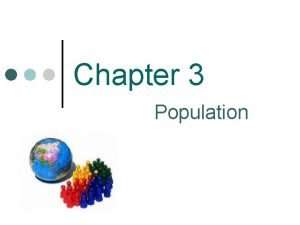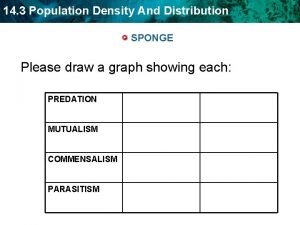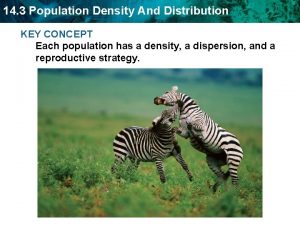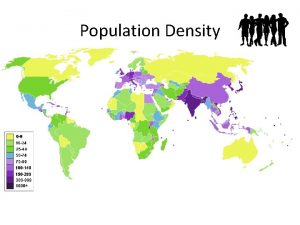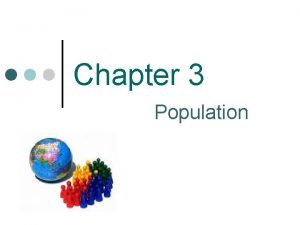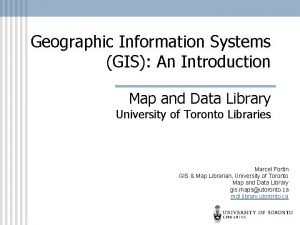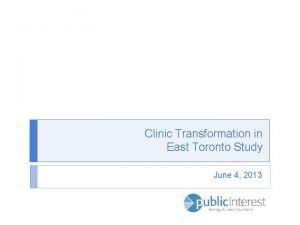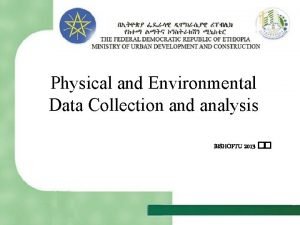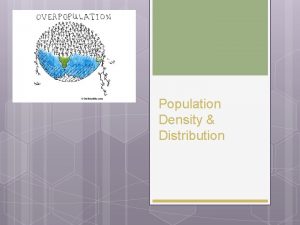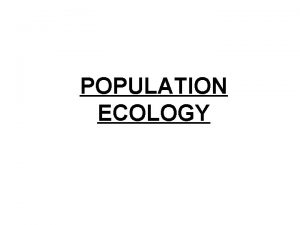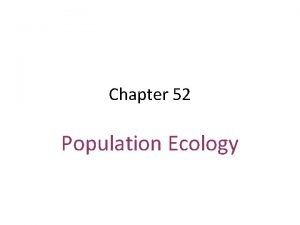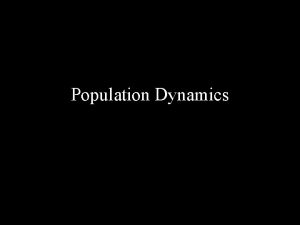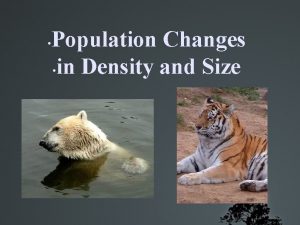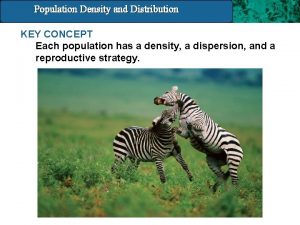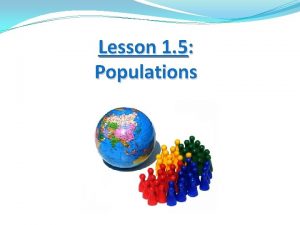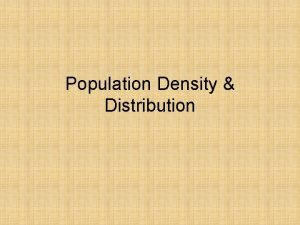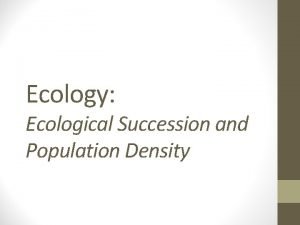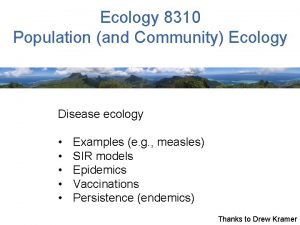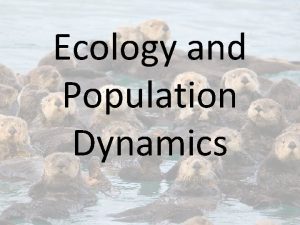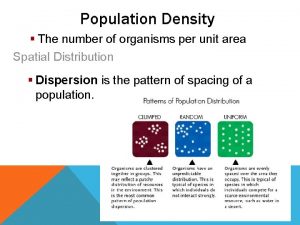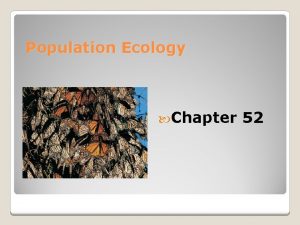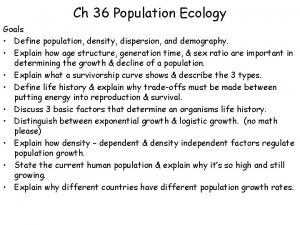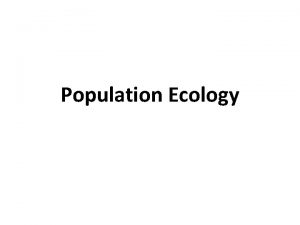POPULATION ECOLOGY Density and Dispersion What is the


















































- Slides: 50

POPULATION ECOLOGY

Density and Dispersion � � What is the density of a population? The number of individuals per unit area Dispersion is how they spread out in that area What are three patterns of dispersion?

Clumped � � Clumped dispersion has population occurring in patches Increased concentration of resources leads to clumping Defense against predators e. g. schools of fish

Uniform Even spacing of individuals within the population Diminishes competition Often seen with plants, they secrete chemicals that prevent germination and growth of individuals that may compete for resources.

Random � � � Spacing is varied and unpredictable Occurs in the absence of strong attraction (concentrated resources) or strong repulsion (avoidance of competition) between individuals. This form of dispersal is rare.

Estimating Population Size � � Mark re-capture method. You capture 200 grasshoppers, mark them all and then release them back into the wild. A few days later you capture 100 grasshoppers and 50 of them were marked. How many grasshoppers do you estimate are in this population? N = # marked x total captured second time number marked recaptures 200 x 100/50 = 400

Density is Dynamic � � � What changes can effect density? Immigration Emigration Births Deaths

Demography � � What is demography? Study of vital statistics that affects population size age structures - relative numbers of individuals at each age. Used to tell if a population is increasing, decreasing or staying the same birthrate, death rate, generation time and sex ratios, all affect interpretation of age structures

Life Tables � � � Summarize the survival pattern of a population Follows the fate of a cohort (group of individuals of the same age) from birth until death Shows the proportion of the cohort surviving from one age to the next


Survivorship Curves � � What is a survivorship curve? Graphic display of the life table Plot of the numbers of a cohort that are alive at each age. Survivorship curves are generally classified into three types:


Characteristics of The Three Types Seen in Survivorship Curves: � � Type I : Low death rate in early years. Small clutch sizes and good care for young Type II: constant mortality throughout life Type III: large clutch size, little care for young high mortality rate early on in life.


Reproductive Tables � � � Age specific summary of reproductive rates in a population. Measures the reproductive output of a cohort from birth until death. Tallies number of female offspring for each age group.

Reproductive Table

Patterns of Reproduction Semelparity – Organisms reproduces only once in its lifetime. Examples: salmon, agave (century plant) � Iteroparity - Organisms reproduce repeatedly throughout their lifetime. �

Life Histories What is the life history of an organism? � Traits that affect time of reproduction and death. 1. Clutch size 2. Number of reproductive episodes per lifetime 3. Age at first reproduction �

What differences can be found in the life histories of these plants?

Parental Care

� � Number of reproductive episodes: Large clutch sizes mean one reproductive episode per life. Small clutch sizes means more than one reproductive episode Age at first reproduction is younger in large clutch size reproducers, they invest less energy in their own growth and development.

Per Capita Rate of Increase � � � Births and Immigration increase the population. Deaths and Emmigration decrease the population. (Births + Immigration) – (Deaths + Emmigration) = Change in population size.

Models of Population Growth � � � r = reproductive rate, r = b-d/N b = births, d = deaths, N = population size multiply both sides of the equation by N, we get: Nr = b-d , Nr = change in population during a given time interval, = DN/Dt * Immigration and emmigration are ignored for simplicity

Models of Population Growth � � � � r = reproductive rate, r = b-d/N b = births, d = deaths, N = population size multiply both sides of the equation by N, we get: Nr = b-d , Nr = change in population during a given time interval, = DN/ Dt = b - d r max = maximal population growth If deaths exceed births r is negative If deaths equal births r is zero (no growth) If births exceed deaths, population is growing.

r max = 1 r max =. 5

After Protection From Hunters

Exponential Growth � � � J shaped curve Unlimited population growth, due to unlimited resources. r selected populations favor the exponential growth curve. Seen in areas with little competition Opportunistic species display this pattern, grasses, insects… But all populations eventually have a limit placed on their growth. . .

Logistic Growth � � � Limiting factors will affect the size of a population Equation becomes: d. N/dt = r max N (K-N/K) K = carrying capacity, varies over space and time When the population is low, N is small and K-N/K is close to 1, so r is close to r max As N approaches K, K-N/K approaches zero and therefore r approaches zero and the population is no longer increasing or decreasing in size.

? K What is occurring here? N is greater than K, so r is negative, deaths exceed births

K What is occurring here? N is less than K, so r is positive, births exceed deaths



Examples of logistic growth: K selected species - likely to be living at carrying capacity, seen in areas with competition

r selected short maturation time short life-span high death rate many offspring/reproduction one reproductive event reproduces early in life small size to offspring no parental care K selected long maturation time long lifespan low death rate few offspring/reproduction several reproductive episodes reproduces later in life large sized offspring parental care for young


Concept Check 1. 2. 3. 4. 5. How is a population growing when N is very small? What changes are occurring when N approaches K? What happens when N is greater than K? What are characteristics of r selected species? What are some characteristics of K selected species?

Population Limiting Factors � � � � Density dependent factors Intensifies as population grows. Density independent factors Affects same number of individuals regardless of population size. A predator is which sort of limiting factor? Density dependent. A hurricane is which sort of limiting factor? Density independent.

�Density-dependent factors increase their affect on a population as population density increases. This is a type of negative feedback. �Density-independent factors are unrelated to population density, and there is no feedback to slow population growth. Fig. 52. 13 Copyright © 2002 Pearson Education, Inc. , publishing as Benjamin Cummings

What sort of limiting factor is seen here?

What sort of limiting factor is seen here?

Is the moose population stable or unstable?

Describe the population shifts seen below:

Human Population Growth � � � Human population is no longer growing exponentially, but is still increasing rapidly. Population still growing, but rate of growth is decreasing. Result of changes due to diseases, including AIDS, and voluntary population control.

Are we at carrying capacity?


Patterns of Population Change � � Population Dynamics vary from region to region. Zero Population = High birth rate – High Death Rate Zero Population = Low Birth rate – Low Death rate Move from first to second called demographic Transition.


Age Structure Diagrams � � Shows relative number of individuals of each age in the pyramid. Bottom heavy, lots of youth that will grow up reproduce and sustain explosive growth. Small base, small number of reproductive individuals. Also predicts social conditions.


Concept Check 1. 2. Which population is k - selected, Type II or Type III? Determine if the following are density dependent or density independent factors. a. b. c. 3. Tornado Infectious disease Food Draw an age structure that displays a population that is increasing.
 Population ecology section 1 population dynamics
Population ecology section 1 population dynamics Population ecology section 1 population dynamics answer key
Population ecology section 1 population dynamics answer key Population ecology section 1 population dynamics
Population ecology section 1 population dynamics Chapter 4 section 1 population dynamics study guide
Chapter 4 section 1 population dynamics study guide Dispersion phase and dispersion medium
Dispersion phase and dispersion medium Kinetic properties of colloids
Kinetic properties of colloids Intramodal dispersion
Intramodal dispersion Crude population density vs physiological density
Crude population density vs physiological density Specific gravity definition
Specific gravity definition Planar density units
Planar density units Linear atomic density
Linear atomic density Population ecology example
Population ecology example The concept of population
The concept of population Is india near the equator
Is india near the equator Population vs community ecology
Population vs community ecology Concept 3 population ecology
Concept 3 population ecology Chapter 53 population ecology
Chapter 53 population ecology Chapter 36 population ecology
Chapter 36 population ecology Ecology
Ecology Survivorship curve def
Survivorship curve def Chapter 53 population ecology
Chapter 53 population ecology Characteristic of population
Characteristic of population Chapter 4 section 1 population dynamics answer key
Chapter 4 section 1 population dynamics answer key Population characteristics
Population characteristics Ideal population growth curve
Ideal population growth curve Population definition ecology
Population definition ecology Population ecology
Population ecology Parasitism pictures
Parasitism pictures Chapter 53 population ecology
Chapter 53 population ecology High density low density
High density low density Physiological population density
Physiological population density Tennessee population density map
Tennessee population density map Pop density formula
Pop density formula Nj population density
Nj population density Physiological density
Physiological density Functional regions
Functional regions Hackney population density
Hackney population density Physiological density
Physiological density Crude population density
Crude population density Physiological density
Physiological density How to calculate population density
How to calculate population density Random population distribution
Random population distribution How to calculate population density
How to calculate population density Population density example
Population density example Population density example
Population density example Chapter 27 physical geography of east asia
Chapter 27 physical geography of east asia China density of population
China density of population Toronto population density
Toronto population density Toronto population density
Toronto population density Population density map australia
Population density map australia Population density formula
Population density formula






